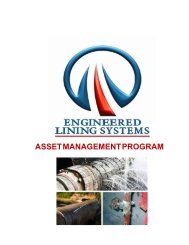Asset Management Program 100319
Create successful ePaper yourself
Turn your PDF publications into a flip-book with our unique Google optimized e-Paper software.
ASSET MANAGEMENT PROGRAM
Engineered Lining Systems <strong>Asset</strong> <strong>Management</strong> <strong>Program</strong> is recognized<br />
by property managers, owners and end users because of its proven<br />
value to your assets’ infrastructure. This program consists of two<br />
processes with specialty designed phases.<br />
ASSET MANAGEMENT PROGRAM<br />
The 1st step of the program is the Infrastructure Assessment Process,<br />
which consists of information gathering, diagnostics, planning and reporting.<br />
The 2nd step of the program is the Infrastructure Rehabilitation Process,<br />
which consists of rehabilitation of the deteriorating infrastructure.
INFRASTRUCTURE ASSESSMENT<br />
PROCESS<br />
Key Components of<br />
Infrastructure Assessment Process<br />
DISCOVERY & PLANNING<br />
PIPE CLEANING/DEBRIS REMOVAL<br />
INVESTIGATION<br />
REPORTING<br />
Working closely with the asset management team, ELS will gather information and<br />
provide a planned approach to execute the process. After information is collected<br />
and compiled into our database, we assemble reporting documents. These<br />
documents may include an array of pipe reports, infrastructure classifications with<br />
life expectancies, updated plans, GPS coordinates in Excel format and overlays<br />
on satellite views in PDF format. You will now have comprehensive information<br />
and documentation to effectively manage your infrastructure.
DISCOVERY & PLANNING<br />
Discovery<br />
The 1st step in the <strong>Asset</strong> <strong>Management</strong> <strong>Program</strong> is Discovery. Discovery<br />
is crucial because the information gathered is the basis for designing the<br />
planned approach to the overall objectives in the Infrastructure<br />
Assessment Process. The Project Manager and Superintendent will<br />
initiate Discovery by conducting a site visit and meeting with the asset<br />
management team. During this site visit, ELS will obtain any available<br />
plans, contact information and project layout.<br />
Planning<br />
ELS will provide a planned approach for approval to the asset<br />
management team. This plan will factor in schedules, flow rates, access<br />
points and hours of operation. Taking this planned approach will result in<br />
a blueprint being developed by the Project Manager and Superintendent.<br />
This blueprint will serve as an outline for the following steps in this<br />
program.
PIPE CLEANING/DEBRIS REMOVAL<br />
about other<br />
clearing methods<br />
Hydro-jetting consists of a high-pressure hose with a specialized nozzle connected to<br />
a machine that pressurizes the water. Hydro-Jetting machines produce a powerful<br />
stream that clears the infrastructure systems to provide proper access for the CCTV<br />
inspection.
INVESTIGATION<br />
(CCTV)<br />
Video cameras are one of the most essential components in the ELS toolbox for<br />
trenchless technology. ELS will meet all the CCTV pipeline inspection needs for<br />
the reporting phase, by providing high quality equipment and experienced crews.<br />
ELS utilizes waterproof, manual and remote control camera systems to analyze<br />
and report the structural condition of your infrastructure. Radio transmitters located<br />
on the camera record the depth and physical location of defects or obstructions to<br />
accurately diagnose your assets. Some identifiable problem areas would be<br />
grease buildup, root intrusion, misalignment, pinhole leaks, broken and corroded<br />
piping systems. In addition, the inspection will identify branch lines locations.<br />
Branch lines will need to be classified as active or inactive. CCTV equipment will<br />
produce engineered quality reports that will be provided with deliverables. The<br />
images and video will be saved for your permanent records and used during the<br />
reporting phase. The reports helps you understand and manage your assets for<br />
piping systems from 2” to 72”.
GEOGRAPHIC INFO SYSTEM<br />
The Geographic Information System (GIS) is designed to capture, store,<br />
manipulate, analyze, manage and present all types of geographical data.<br />
REPORTING<br />
Reporting is the final phase of the Infrastructure Assessment Process. ELS will<br />
provide all CCTV Reports, Updated Plans, Satellite Images with GIS overlay<br />
(PDF), GPS coordinates (Excel) and Classifications of infrastructure with<br />
remaining life span as required by contract. All deliverables and essential<br />
information can be used for planning, budgeting, management of your asset and<br />
forecasting failures in your infrastructure. ELS can now apply the second process<br />
of this program to prevent these failures from happening.
SAMPLE OF REMAINING<br />
USEFUL LIFE CHART<br />
Line Size Sanitary A B C<br />
3" to 6" 0 0 0 0<br />
8" to 10" 3634 1428 881 1325<br />
Totals 3634 1428 881 1325<br />
Line Size<br />
Storm<br />
3" to 6" 0 0 0 0<br />
8" to 10" 107 0 107 0<br />
12" to 16" 372 0 69 303<br />
18" to 24" 2971 504 796 1671<br />
25" to 30" 1767 593 986 188<br />
32" to 36" 933 0 17 916<br />
38" to 42" 0 0 0 0<br />
46" to 52" 43 43 0 0<br />
54" to 60" 1320 353 697 270<br />
66" to 72" 1659 104 1555 0<br />
75" to 86" 0 0 0 0<br />
Totals 9172 1597 4227 3348<br />
Sanitary 3634<br />
Storm 9172<br />
Total 12806<br />
.<br />
A<br />
B<br />
C<br />
Like New Condition<br />
Some Minor Defects, Reevaluation in 3 to 5 Years<br />
Major Defects and Immediate Repairs are Recommended
INFRASTRUCTURE REHABILITATION<br />
PROCESS<br />
The 2 nd step of the program is the Infrastructure Rehabilitation Process. This<br />
process consists of planning and executing the rehabilitation of the deteriorating<br />
infrastructure. Engineered Lining Systems provides several options when<br />
rehabilitating infrastructure. The process and material can change depending on<br />
the application, type of drainage system and access to the infrastructure in<br />
question. The rehabilitation method will be determined during the planning<br />
phase of this process.
PLANNING<br />
The reporting from the <strong>Asset</strong> Assessment Process is the blueprint for planning the<br />
rehabilitation. ELS will have a Project Manager and Superintendent working together<br />
during the planning phase. The planning phase of the interior and exterior<br />
rehabilitation will have different schedules, logistics, materials and level of<br />
coordination. ELS will use its network of worldwide suppliers and engineers to provide<br />
the solution to extend the life of the asset 50 to 70 years.<br />
Planning the interior infrastructure involves specific challenges with flow rates,<br />
bypassing, access to tenant space, working hours and material cure times. These<br />
challenges will be overcome by using specialty trained technicians, an on-site<br />
superintendent, and a project manager from headquarters.<br />
Planning the exterior phase involves similar challenges to interior but not identical.<br />
Maintenance of traffic, bypassing, parking spaces, working hours, equipment staging<br />
and material cure times. Engineering is taken to a different level due to the increase in<br />
pipe diameter and ground water levels. These challenges will be overcome by using<br />
licensed engineers, trained technicians, on site superintendant and a project manager<br />
from headquarters.
INFRASTRUCTURE REMEDIES<br />
CURED IN PLACE PIPE (CIPP) REMEDY<br />
A fiberglass or felt sleeve is impregnated with resin and is inflated with air or water. After<br />
the liner is inserted into the pipe. The resin is hardened by Ultraviolet light or Thermal<br />
setting with heat and steam. Ultra-Violet Cured in Place Pipe (UV CIPP) not only is the<br />
most environmentally sound trenchless technology on the market today but also has the<br />
highest production value, allowing multiple pipe runs to be rehabilitated over the course of<br />
an 8 to 10-hour day.
EPOXY COATING REMEDY<br />
Epoxy coating is also an excellent option for interior infrastructure rehabilitation.<br />
The epoxy method is applied by spin casting or brushing, P-traps and turns<br />
in the piping system are restored to optimal condition with this method.<br />
.
CONSTRUCTION BUILD BACK<br />
If any alterations to the interior or exterior of the property is required such as<br />
wall removal, digging of pit or trench, ELS will restore as close to previous<br />
condition as possible. While work is being performed ELS will temporarily<br />
close these areas off to minimize impact to owners or customers.<br />
REPORTING<br />
Once, the rehabilitation phase is complete, ELS will collect and enter all<br />
updated information into our database, ELS will then update the asset<br />
documents. These assets documents may include an array of pipe reports,<br />
classification with life expectancies, updated plans, GPS coordinates in excel<br />
format and overlays on satellite views in PDF format. You will now have the<br />
proper information and documentation to manage your assets.
Engineered Lining Systems works with clients nationally and internationally to<br />
successfully rehabilitate and restore piping and structures for commercial,<br />
governmental, industrial, educational and military facilities using our cutting-edge and<br />
environmentally sound trenchless technology. We appreciate your time and would<br />
love the opportunity to discuss with you and your company further how ELS can<br />
better serve your infrastructure needs.<br />
Nationwide Service<br />
888-384-9549<br />
WWW.ENGINEEREDLINING.COM
















